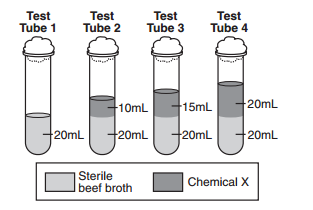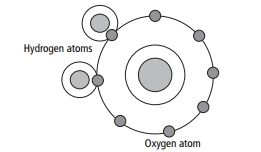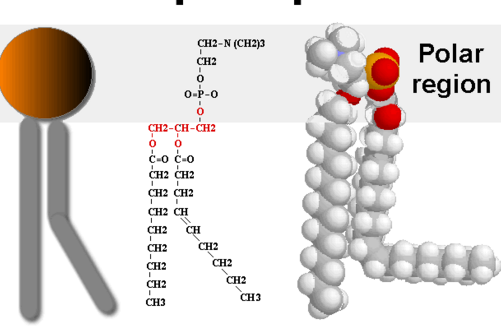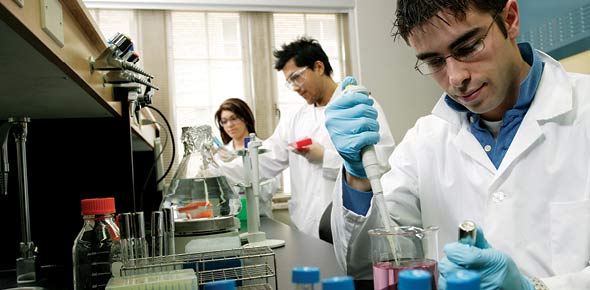Experiments In The Laboratory! Trivia Questions Quiz
-
DNA and RNA are two types of ____________________________ which are composed of the subunits ________________________ .
-
Carbohydrates - glucose
-
Lipids - fatty acids
-
Proteins - amino acids
-
Nucleic acids - nucleotides
-
Explore the fascinating world of biochemistry with 'Experiments in the Laboratory! Trivia Questions Quiz'. This quiz assesses knowledge on biochemical principles, from the structure of polymers to the properties of lipids and proteins. Ideal for students and enthusiasts eager to test their understanding in a practical context.

Quiz Preview
- 2.
Stomach acid is considered
-
A strong base
-
Neutral
-
A weak base
-
A strong acid
Correct Answer
A. A strong acidExplanation
Stomach acid is considered a strong acid because it has a low pH value and can easily donate hydrogen ions. It is primarily composed of hydrochloric acid (HCl), which is a highly corrosive and acidic compound. Stomach acid plays a crucial role in the digestion process by breaking down food and killing harmful bacteria. Its strong acidic nature helps in the breakdown of proteins and activates digestive enzymes.Rate this question:
-
- 3.
You suspect that a chemical that you are testing in the lab is strongly basic. What might be its pH?
-
2
-
7
-
11
-
14
Correct Answer
A. 14Explanation
A pH of 14 indicates a highly alkaline or basic substance. The pH scale ranges from 0 to 14, with 7 being neutral. A pH of 14 suggests that the chemical being tested has a high concentration of hydroxide ions (OH-) compared to hydrogen ions (H+). This indicates a strong base, as it has a high capacity to accept protons and release hydroxide ions.Rate this question:
-
- 4.
Different organisms store glucose in various forms. You discover a new species. Upon chemical analysis, you find that it is comprised of significant amounts of starch. To which organism might this new species be related?
-
Fern
-
Potato
-
Dog
-
Bacteria
Correct Answer
A. PotatoExplanation
The presence of significant amounts of starch in the new species suggests that it is related to the potato. Starch is a common storage form of glucose in plants, and potatoes are known for their high starch content. In contrast, ferns typically store glucose as glycogen, dogs store it as glycogen and fat, and bacteria store it as glycogen or other forms. Therefore, the presence of starch points towards a plant organism like the potato.Rate this question:
-
- 5.
Large bodies of water, such as lake and oceans, do not quickly fluctuate in temperature. What is the reason for the phenomenon?
-
Water is an acid
-
Water is a versatile solvent
-
Water acts as a buffer
-
Water has a high heat capacity
Correct Answer
A. Water has a high heat capacityExplanation
Large bodies of water, such as lakes and oceans, do not quickly fluctuate in temperature because water has a high heat capacity. This means that water can absorb and store a large amount of heat energy without experiencing significant changes in temperature. As a result, it takes a longer time for large bodies of water to heat up or cool down compared to other substances. This property helps to stabilize the temperature of bodies of water, preventing rapid fluctuations and creating a more stable environment for aquatic life.Rate this question:
-
- 6.
If you were testing the pH of baking soda, you would expected the pH to be
-
Acidic
-
Basic
-
Neutral
-
Neagative
Correct Answer
A. BasicExplanation
Baking soda, also known as sodium bicarbonate, is an alkaline compound. When dissolved in water, it forms a basic solution. Therefore, when testing the pH of baking soda, it is expected to be basic.Rate this question:
-
- 7.
A biochemist is performing an experiment to determine the effect of chemical X on the growth of bacteria. Which test tube is the control?
-
Test Tube 1
-
Test Tube 2
-
Test Tube 3
-
Test Tube 4
Correct Answer
A. Test Tube 1Explanation
In an experiment, the control group is the group that does not receive the experimental treatment and is used as a baseline for comparison. In this case, Test Tube 1 is the control because it does not contain chemical X. By comparing the growth of bacteria in Test Tube 1 to the other test tubes that do contain chemical X, the biochemist can determine the effect of chemical X on the growth of bacteria.Rate this question:
-
- 8.
You are analyzing a compound in a laboratory. You find that it is made up of carbon, hydrogen, and oxygen in a ratio of one carbon, two hydrogen, and one oxygen atom. How will you classify the compound?
-
Carbohydrate
-
Lipid
-
Protein
-
Nucleic acid
Correct Answer
A. CarbohydrateExplanation
Based on the given information about the compound's composition of one carbon, two hydrogen, and one oxygen atom, it can be classified as a carbohydrate. Carbohydrates are organic compounds that consist of carbon, hydrogen, and oxygen atoms in a specific ratio, typically in the form of a sugar or starch.Rate this question:
-
- 9.
Which does a polymer most closely resemble?
-
Circle
-
Link in a chain
-
Chain
-
Intersection
Correct Answer
A. ChainExplanation
A polymer most closely resembles a chain. A polymer is a large molecule made up of repeating subunits called monomers that are linked together in a linear fashion, similar to how links are connected in a chain. This structure allows polymers to have flexibility and the ability to stretch and bend, just like a chain.Rate this question:
-
- 10.
What makes a water molecule polar?
-
Water has the ability to be frozen.
-
The pH of pure water varies with the temperature.
-
A water molecule has a slight charge on each end.
-
A water molecule is made up of three atoms.
Correct Answer
A. A water molecule has a slight charge on each end.Explanation
Water molecules are polar because they have a slight charge on each end. This is due to the unequal sharing of electrons between the oxygen and hydrogen atoms in the molecule. The oxygen atom attracts the shared electrons more strongly than the hydrogen atoms, creating a partial negative charge near the oxygen atom and partial positive charges near the hydrogen atoms. This polarity allows water molecules to form hydrogen bonds with each other, giving water its unique properties such as high surface tension and the ability to dissolve many substances.Rate this question:
-
- 11.
You are conducting an experiment to determine the presence of simple reducing sugars such as monosaccharides. Which indicator would you use to test for the presence of glucose?
-
Hydrogen Perioxide
-
Iodine
-
Benedict's solution
-
Biuret reagent
Correct Answer
A. Benedict's solutionExplanation
Benedict's solution is used to test for the presence of simple reducing sugars such as glucose. It contains copper sulfate, which reacts with the aldehyde or ketone functional groups in reducing sugars, forming a red precipitate. This color change indicates the presence of glucose in the solution.Rate this question:
-
- 12.
You are conducting a test to test for the presence of protein in a sample. What test or solution would you use and what would be you indication of positive for the presence of protein.
-
Iodine test; dark purple to black color change
-
Hydrogen Peroxide; presence of bubbles
-
Benedict's solution; dark brick red to brown color change after heating
-
Biuret test; lavender to dark purple color change
Correct Answer
A. Biuret test; lavender to dark purple color changeExplanation
The correct answer is the Biuret test. This test is used to detect the presence of proteins in a sample. When the Biuret reagent is added to a solution containing protein, it forms a complex with the peptide bonds in the protein. This complex results in a color change from lavender to dark purple. Therefore, a dark purple color change indicates a positive result for the presence of protein in the sample.Rate this question:
-
- 13.
Two of the four classes of organic compounds are proteins and nucleic acids. What is the relationship between proteins and nucleic acids?
-
Nucleic acids use proteins for energy
-
Nucleic acids are monomer of proteins
-
Proteins are long polymer of nucleic acids
-
Nucleic acids contain the instructions to make proteins
Correct Answer
A. Nucleic acids contain the instructions to make proteinsExplanation
Proteins and nucleic acids have a relationship where nucleic acids contain the instructions to make proteins. Nucleic acids, such as DNA and RNA, carry the genetic information that determines the sequence of amino acids in proteins. This information is then used by the cell to synthesize proteins through a process called protein synthesis. Therefore, nucleic acids play a crucial role in the production of proteins.Rate this question:
-
- 14.
What structure is being shown in the image?
-
Phospholipid
-
Oil
-
Cholesterol
-
Glycoprotein
Correct Answer
A. PhospholipidExplanation
The structure being shown in the image is a phospholipid. Phospholipids are a type of lipid that make up the cell membrane. They consist of a hydrophilic (water-loving) head and two hydrophobic (water-repelling) tails. This structure allows phospholipids to form a bilayer in the cell membrane, with the hydrophilic heads facing outward towards the watery environment and the hydrophobic tails facing inward. This arrangement helps to maintain the integrity and fluidity of the cell membrane.Rate this question:
-
- 15.
Small insects can walk across the surface of calm water but they do not break the surface of the water and fall under. What property of water to have surface tension?
-
Adhesion
-
Cohension
-
Hydrolysis
-
High specific heat
Correct Answer
A. CohensionExplanation
The correct answer is cohesion. Cohesion is the property of water that allows it to stick to itself, creating a strong bond between water molecules. This cohesive force is what gives water its surface tension, enabling small insects to walk on the surface without breaking it. Adhesion, on the other hand, refers to the ability of water to stick to other substances, hydrolysis is a chemical reaction involving water, and high specific heat is a different property of water unrelated to surface tension.Rate this question:
-
- 16.
A florist place a bouquet of white carnations in water containing blue dye. After a time, the flower petals turn blue. What process helped the carnations change color?
-
Specific heat
-
Surface tension
-
Cohension and adhesion of water molecules
-
Formation of covalent bonds between hydrogen and oxygen molecules.
Correct Answer
A. Cohension and adhesion of water moleculesExplanation
The cohesion and adhesion of water molecules is the process that helped the carnations change color. Cohesion refers to the attraction between water molecules, causing them to stick together, while adhesion refers to the attraction between water molecules and other substances. In this case, the water molecules adhered to the petals of the carnations and the blue dye dissolved in the water, causing the petals to absorb the blue dye and change color.Rate this question:
-
- 17.
The diagram below shows two amino acids. What would biochemists call the result of chaining many of these molecules together?
-
A carbohydrate
-
A lipid
-
A nucleic acid
-
A protein
Correct Answer
A. A proteinExplanation
The diagram shows two amino acids, which are the building blocks of proteins. When many amino acids are linked together in a chain, it forms a protein. Therefore, biochemists would call the result of chaining many of these molecules together a protein.Rate this question:
-
- 18.
The bond formed between the oxygen of one water molecule to the hydrogen of a different water molecule is called a ______________________ bond.
-
Covalent
-
Ionic
-
Dehydration
-
Hydrogen
Correct Answer
A. HydrogenExplanation
The bond formed between the oxygen of one water molecule to the hydrogen of a different water molecule is called a hydrogen bond. This type of bond is a weak attraction between the partial positive charge of the hydrogen atom and the partial negative charge of the oxygen atom in a water molecule. Hydrogen bonds play a crucial role in many biological processes and properties of water, such as its high boiling point and surface tension.Rate this question:
-
- 19.
Which is NOT true of lipids?
-
They are commonly called fats and oils.
-
They are hydrophobic.
-
They are good for energy storage.
-
They are polar.
Correct Answer
A. They are polar.Explanation
Lipids are commonly called fats and oils because they are insoluble in water and soluble in organic solvents. They are hydrophobic, meaning they repel water. Lipids are known to be good for energy storage as they contain more energy per gram compared to carbohydrates. However, lipids are not polar molecules, as they do not have a charge separation and do not dissolve in water.Rate this question:
-
- 20.
Which class of macromolecules store and communicate genetic information?
-
Carbohydrates
-
Lipids
-
Proteins
-
Nucleic acids
Correct Answer
A. Nucleic acidsExplanation
Nucleic acids are the class of macromolecules that store and communicate genetic information. This is because nucleic acids, specifically DNA and RNA, contain the genetic code that determines the characteristics and functions of living organisms. DNA stores the genetic information, while RNA helps to transmit and express this information. Carbohydrates, lipids, and proteins have important roles in the body, but they do not directly store or communicate genetic information.Rate this question:
-
Quiz Review Timeline (Updated): Mar 22, 2023 +
Our quizzes are rigorously reviewed, monitored and continuously updated by our expert board to maintain accuracy, relevance, and timeliness.
-
Current Version
-
Mar 22, 2023Quiz Edited by
ProProfs Editorial Team -
Feb 08, 2017Quiz Created by
Marilyn Milton
Struggling To Pass BioChemistry In Midterm? This Quiz Is The Key
Biochemistry is the application of chemistry to the study of biological processes at the cellular and molecular level. It emerged as a distinct discipline around the...
Questions:
29 |
Attempts:
444 |
Last updated:
Mar 21, 2023
|
Biochemistry Drugs, DNA & RNA Quiz
Biochemistry is the branch of science that studies the chemical processes taking place within and related to living organisms. Check out our online quiz and see well versed are...
Questions:
100 |
Attempts:
432 |
Last updated:
Feb 06, 2024
|
Vitamins, Enzymes And Fibers Quiz!
Explore key biological and chemical concepts in the 'Vitamins, Enzymes, and Fibers Quiz!' This quiz assesses knowledge on enzymes like amylase and papain, the role of vitamins,...
Questions:
10 |
Attempts:
274 |
Last updated:
Mar 19, 2023
|
Carbohydrates And Lipids Semi-Final Examination 2019
There is a mix of multiple choice and fill in the blank questions.
Select the best answer before proceeding, you can not review your answered questions. It's a one touch...
Questions:
100 |
Attempts:
384 |
Last updated:
Sep 03, 2023
|
MCQ Snacks -One Liners
This quiz titled 'MCQ Snacks - One liners' features multiple-choice questions on biochemistry and molecular biology topics, including amino acids, UV absorption, and cell membrane...
Questions:
20 |
Attempts:
142 |
Last updated:
Mar 21, 2023
|
Bio 103 5th Chapter
Bio 103 5th chapter quiz assesses knowledge on biochemistry topics such as carbohydrates, unsaturated fats, DNA structure, enzymatic reactions, and hydrolysis. It evaluates...
Questions:
11 |
Attempts:
236 |
Last updated:
Mar 21, 2023
|
 Back to top
Back to top












